BIOSCIENCE 401002 Part B Assignment: Human Body Systems Analysis
VerifiedAdded on 2021/06/14
|6
|1009
|165
Homework Assignment
AI Summary
This assignment solution addresses key aspects of human biology and nutrition. It begins by explaining the importance of body temperature regulation and the skin's role in maintaining homeostasis under varying environmental conditions. The assignment then delves into cardiovascular health, exploring the function of cholesterol, specifically LDL and HDL, and providing dietary recommendations for optimal blood cholesterol levels. Finally, the solution examines the roles of vitamin B9 (folate) and iron, including food sources, their functions in pregnant and non-pregnant individuals, and the consequences of nutrient deficiencies. This assignment provides a comprehensive overview of these essential biological concepts.

Running head: BIOSCIENCE 401002 PART B
Bioscience 401002 Part B
Student’s Name
Institutional Affiliation
Bioscience 401002 Part B
Student’s Name
Institutional Affiliation
Paraphrase This Document
Need a fresh take? Get an instant paraphrase of this document with our AI Paraphraser
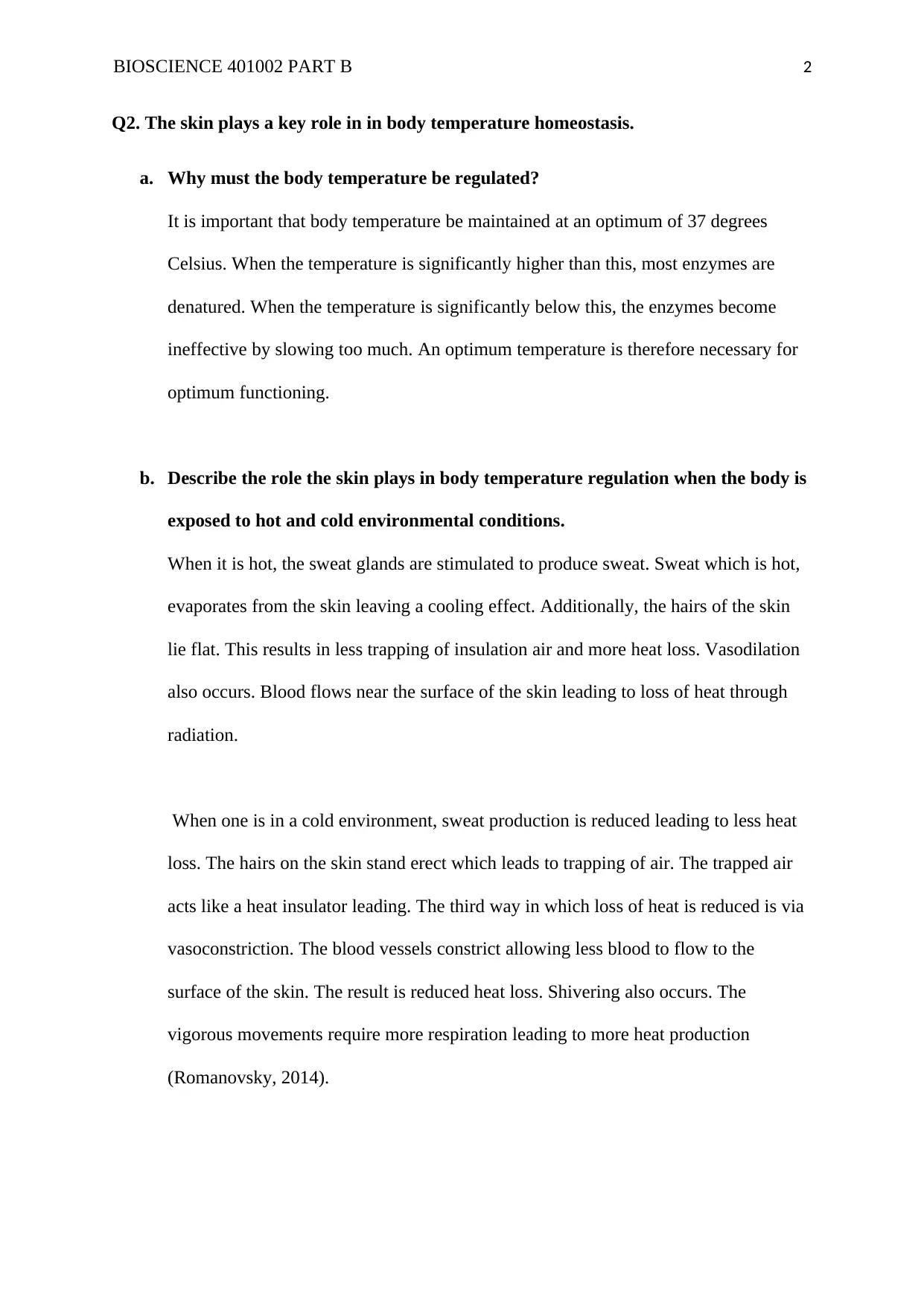
BIOSCIENCE 401002 PART B 2
Q2. The skin plays a key role in in body temperature homeostasis.
a. Why must the body temperature be regulated?
It is important that body temperature be maintained at an optimum of 37 degrees
Celsius. When the temperature is significantly higher than this, most enzymes are
denatured. When the temperature is significantly below this, the enzymes become
ineffective by slowing too much. An optimum temperature is therefore necessary for
optimum functioning.
b. Describe the role the skin plays in body temperature regulation when the body is
exposed to hot and cold environmental conditions.
When it is hot, the sweat glands are stimulated to produce sweat. Sweat which is hot,
evaporates from the skin leaving a cooling effect. Additionally, the hairs of the skin
lie flat. This results in less trapping of insulation air and more heat loss. Vasodilation
also occurs. Blood flows near the surface of the skin leading to loss of heat through
radiation.
When one is in a cold environment, sweat production is reduced leading to less heat
loss. The hairs on the skin stand erect which leads to trapping of air. The trapped air
acts like a heat insulator leading. The third way in which loss of heat is reduced is via
vasoconstriction. The blood vessels constrict allowing less blood to flow to the
surface of the skin. The result is reduced heat loss. Shivering also occurs. The
vigorous movements require more respiration leading to more heat production
(Romanovsky, 2014).
Q2. The skin plays a key role in in body temperature homeostasis.
a. Why must the body temperature be regulated?
It is important that body temperature be maintained at an optimum of 37 degrees
Celsius. When the temperature is significantly higher than this, most enzymes are
denatured. When the temperature is significantly below this, the enzymes become
ineffective by slowing too much. An optimum temperature is therefore necessary for
optimum functioning.
b. Describe the role the skin plays in body temperature regulation when the body is
exposed to hot and cold environmental conditions.
When it is hot, the sweat glands are stimulated to produce sweat. Sweat which is hot,
evaporates from the skin leaving a cooling effect. Additionally, the hairs of the skin
lie flat. This results in less trapping of insulation air and more heat loss. Vasodilation
also occurs. Blood flows near the surface of the skin leading to loss of heat through
radiation.
When one is in a cold environment, sweat production is reduced leading to less heat
loss. The hairs on the skin stand erect which leads to trapping of air. The trapped air
acts like a heat insulator leading. The third way in which loss of heat is reduced is via
vasoconstriction. The blood vessels constrict allowing less blood to flow to the
surface of the skin. The result is reduced heat loss. Shivering also occurs. The
vigorous movements require more respiration leading to more heat production
(Romanovsky, 2014).
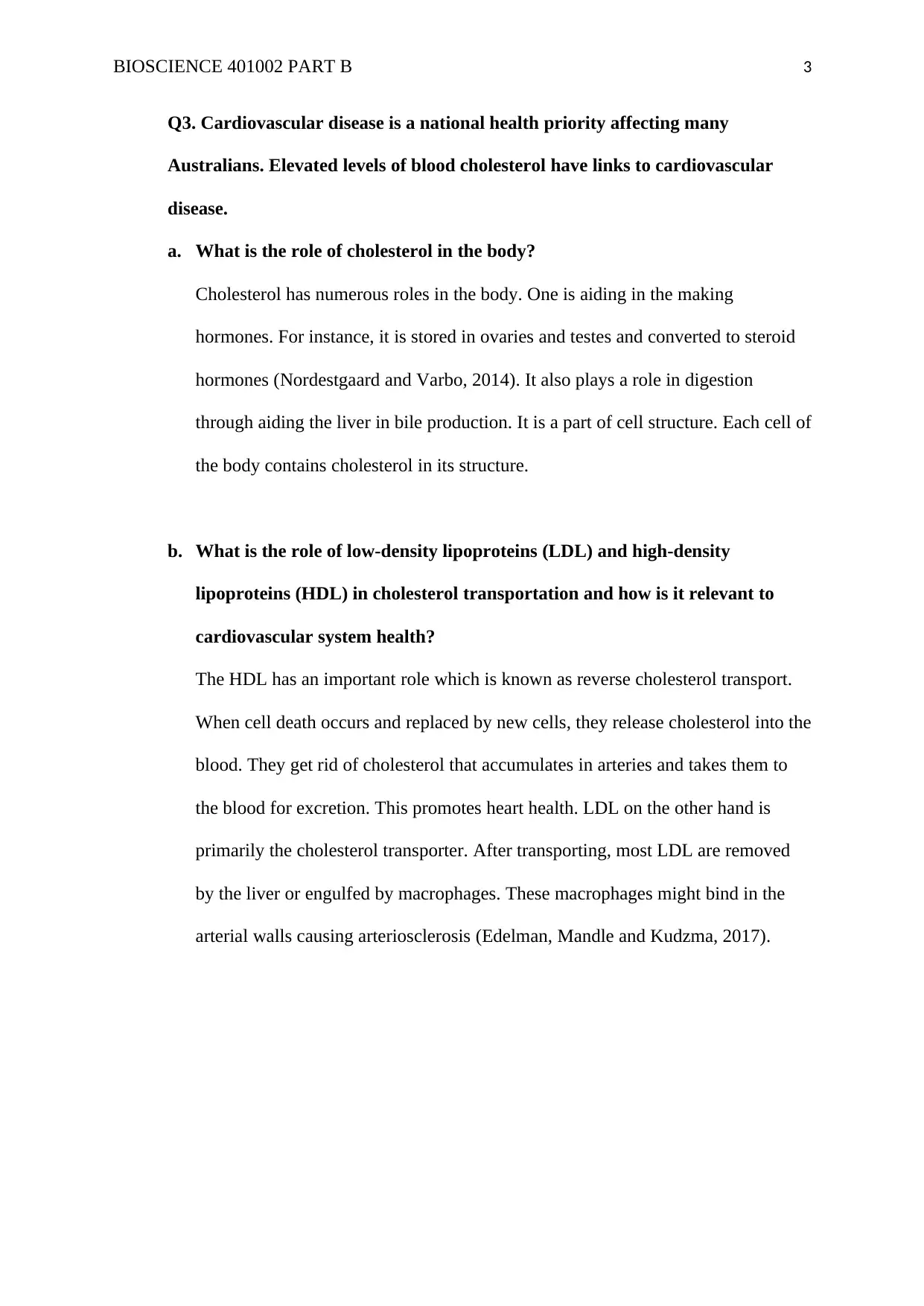
BIOSCIENCE 401002 PART B 3
Q3. Cardiovascular disease is a national health priority affecting many
Australians. Elevated levels of blood cholesterol have links to cardiovascular
disease.
a. What is the role of cholesterol in the body?
Cholesterol has numerous roles in the body. One is aiding in the making
hormones. For instance, it is stored in ovaries and testes and converted to steroid
hormones (Nordestgaard and Varbo, 2014). It also plays a role in digestion
through aiding the liver in bile production. It is a part of cell structure. Each cell of
the body contains cholesterol in its structure.
b. What is the role of low-density lipoproteins (LDL) and high-density
lipoproteins (HDL) in cholesterol transportation and how is it relevant to
cardiovascular system health?
The HDL has an important role which is known as reverse cholesterol transport.
When cell death occurs and replaced by new cells, they release cholesterol into the
blood. They get rid of cholesterol that accumulates in arteries and takes them to
the blood for excretion. This promotes heart health. LDL on the other hand is
primarily the cholesterol transporter. After transporting, most LDL are removed
by the liver or engulfed by macrophages. These macrophages might bind in the
arterial walls causing arteriosclerosis (Edelman, Mandle and Kudzma, 2017).
Q3. Cardiovascular disease is a national health priority affecting many
Australians. Elevated levels of blood cholesterol have links to cardiovascular
disease.
a. What is the role of cholesterol in the body?
Cholesterol has numerous roles in the body. One is aiding in the making
hormones. For instance, it is stored in ovaries and testes and converted to steroid
hormones (Nordestgaard and Varbo, 2014). It also plays a role in digestion
through aiding the liver in bile production. It is a part of cell structure. Each cell of
the body contains cholesterol in its structure.
b. What is the role of low-density lipoproteins (LDL) and high-density
lipoproteins (HDL) in cholesterol transportation and how is it relevant to
cardiovascular system health?
The HDL has an important role which is known as reverse cholesterol transport.
When cell death occurs and replaced by new cells, they release cholesterol into the
blood. They get rid of cholesterol that accumulates in arteries and takes them to
the blood for excretion. This promotes heart health. LDL on the other hand is
primarily the cholesterol transporter. After transporting, most LDL are removed
by the liver or engulfed by macrophages. These macrophages might bind in the
arterial walls causing arteriosclerosis (Edelman, Mandle and Kudzma, 2017).
⊘ This is a preview!⊘
Do you want full access?
Subscribe today to unlock all pages.

Trusted by 1+ million students worldwide
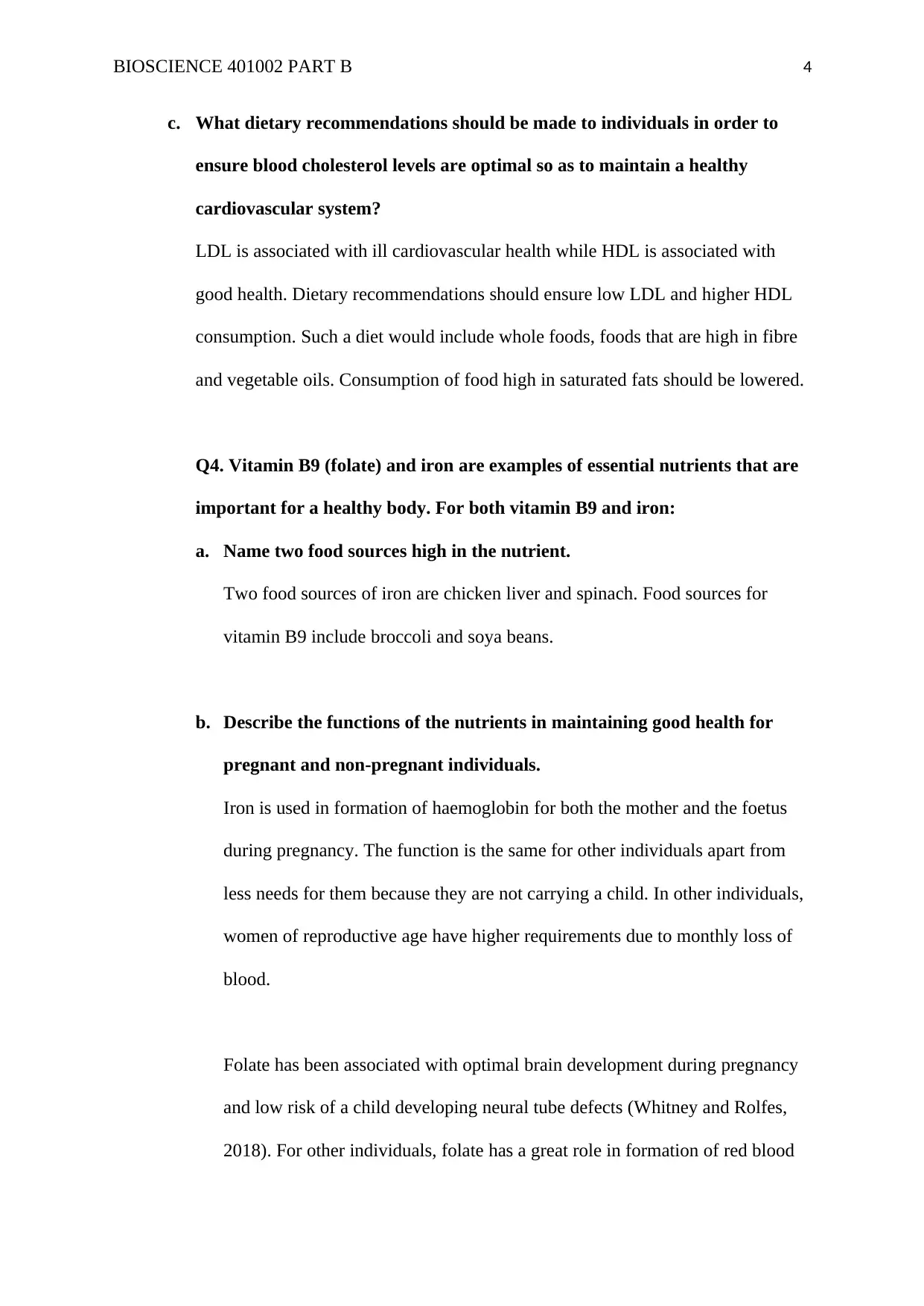
BIOSCIENCE 401002 PART B 4
c. What dietary recommendations should be made to individuals in order to
ensure blood cholesterol levels are optimal so as to maintain a healthy
cardiovascular system?
LDL is associated with ill cardiovascular health while HDL is associated with
good health. Dietary recommendations should ensure low LDL and higher HDL
consumption. Such a diet would include whole foods, foods that are high in fibre
and vegetable oils. Consumption of food high in saturated fats should be lowered.
Q4. Vitamin B9 (folate) and iron are examples of essential nutrients that are
important for a healthy body. For both vitamin B9 and iron:
a. Name two food sources high in the nutrient.
Two food sources of iron are chicken liver and spinach. Food sources for
vitamin B9 include broccoli and soya beans.
b. Describe the functions of the nutrients in maintaining good health for
pregnant and non-pregnant individuals.
Iron is used in formation of haemoglobin for both the mother and the foetus
during pregnancy. The function is the same for other individuals apart from
less needs for them because they are not carrying a child. In other individuals,
women of reproductive age have higher requirements due to monthly loss of
blood.
Folate has been associated with optimal brain development during pregnancy
and low risk of a child developing neural tube defects (Whitney and Rolfes,
2018). For other individuals, folate has a great role in formation of red blood
c. What dietary recommendations should be made to individuals in order to
ensure blood cholesterol levels are optimal so as to maintain a healthy
cardiovascular system?
LDL is associated with ill cardiovascular health while HDL is associated with
good health. Dietary recommendations should ensure low LDL and higher HDL
consumption. Such a diet would include whole foods, foods that are high in fibre
and vegetable oils. Consumption of food high in saturated fats should be lowered.
Q4. Vitamin B9 (folate) and iron are examples of essential nutrients that are
important for a healthy body. For both vitamin B9 and iron:
a. Name two food sources high in the nutrient.
Two food sources of iron are chicken liver and spinach. Food sources for
vitamin B9 include broccoli and soya beans.
b. Describe the functions of the nutrients in maintaining good health for
pregnant and non-pregnant individuals.
Iron is used in formation of haemoglobin for both the mother and the foetus
during pregnancy. The function is the same for other individuals apart from
less needs for them because they are not carrying a child. In other individuals,
women of reproductive age have higher requirements due to monthly loss of
blood.
Folate has been associated with optimal brain development during pregnancy
and low risk of a child developing neural tube defects (Whitney and Rolfes,
2018). For other individuals, folate has a great role in formation of red blood
Paraphrase This Document
Need a fresh take? Get an instant paraphrase of this document with our AI Paraphraser
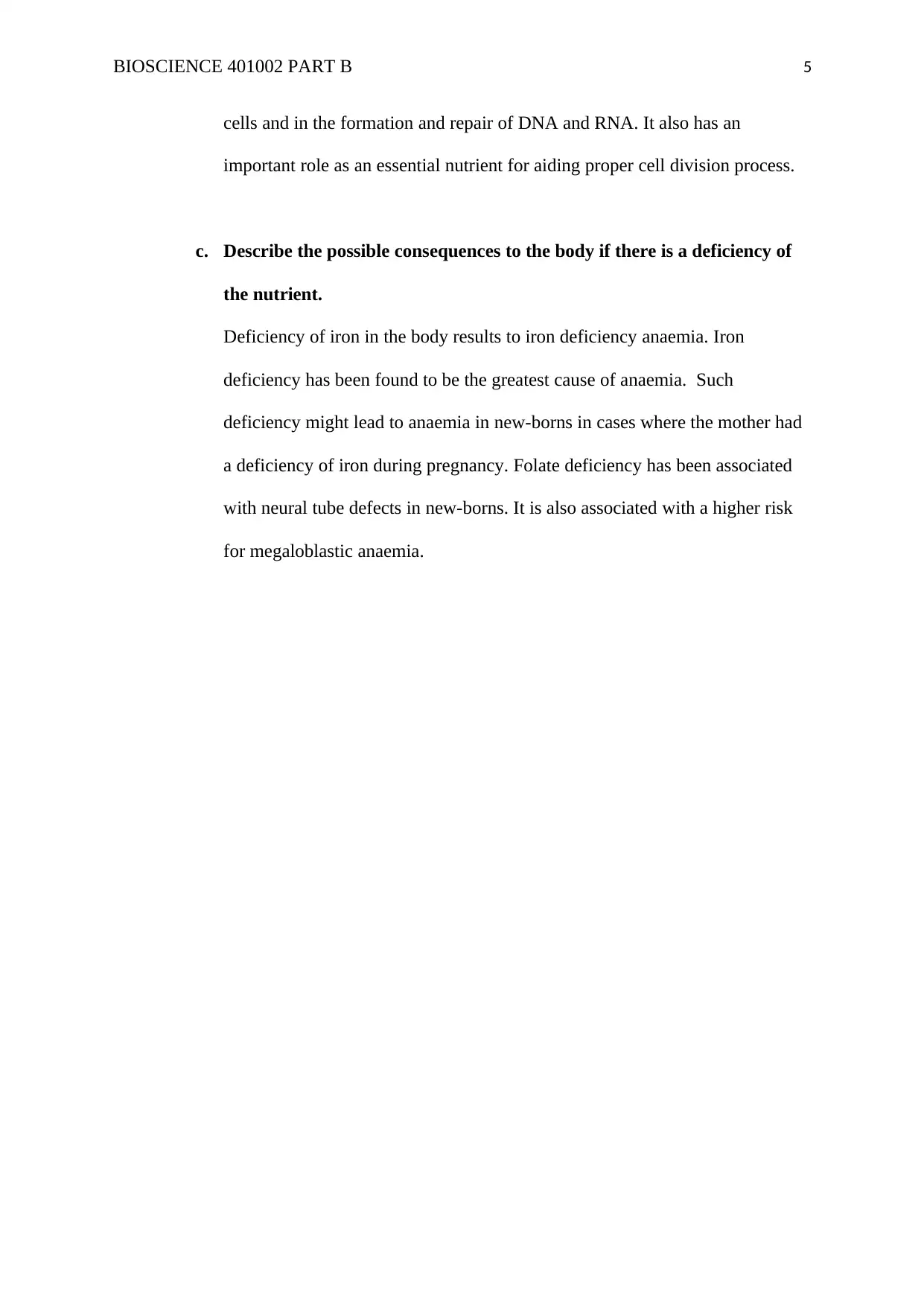
BIOSCIENCE 401002 PART B 5
cells and in the formation and repair of DNA and RNA. It also has an
important role as an essential nutrient for aiding proper cell division process.
c. Describe the possible consequences to the body if there is a deficiency of
the nutrient.
Deficiency of iron in the body results to iron deficiency anaemia. Iron
deficiency has been found to be the greatest cause of anaemia. Such
deficiency might lead to anaemia in new-borns in cases where the mother had
a deficiency of iron during pregnancy. Folate deficiency has been associated
with neural tube defects in new-borns. It is also associated with a higher risk
for megaloblastic anaemia.
cells and in the formation and repair of DNA and RNA. It also has an
important role as an essential nutrient for aiding proper cell division process.
c. Describe the possible consequences to the body if there is a deficiency of
the nutrient.
Deficiency of iron in the body results to iron deficiency anaemia. Iron
deficiency has been found to be the greatest cause of anaemia. Such
deficiency might lead to anaemia in new-borns in cases where the mother had
a deficiency of iron during pregnancy. Folate deficiency has been associated
with neural tube defects in new-borns. It is also associated with a higher risk
for megaloblastic anaemia.
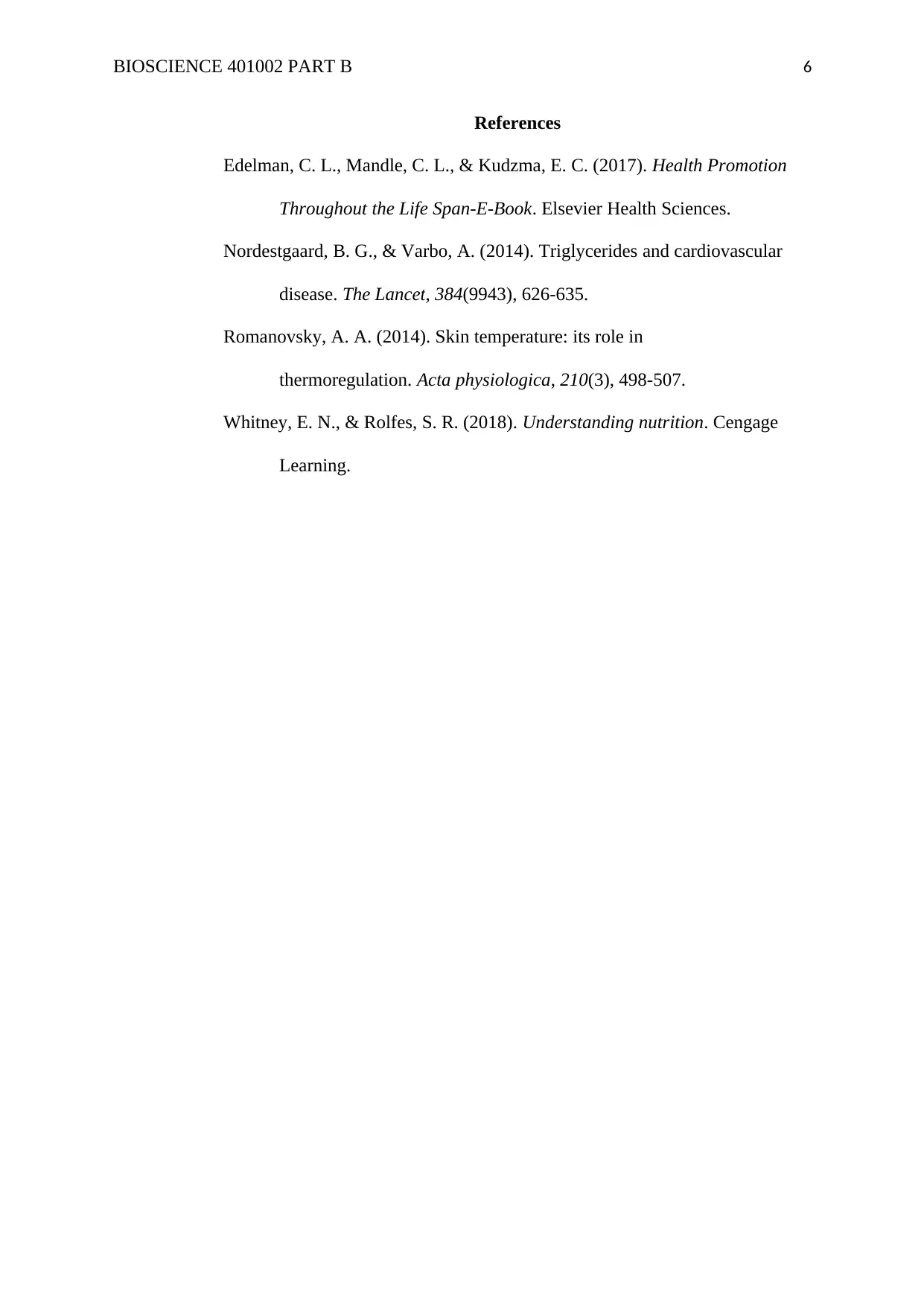
BIOSCIENCE 401002 PART B 6
References
Edelman, C. L., Mandle, C. L., & Kudzma, E. C. (2017). Health Promotion
Throughout the Life Span-E-Book. Elsevier Health Sciences.
Nordestgaard, B. G., & Varbo, A. (2014). Triglycerides and cardiovascular
disease. The Lancet, 384(9943), 626-635.
Romanovsky, A. A. (2014). Skin temperature: its role in
thermoregulation. Acta physiologica, 210(3), 498-507.
Whitney, E. N., & Rolfes, S. R. (2018). Understanding nutrition. Cengage
Learning.
References
Edelman, C. L., Mandle, C. L., & Kudzma, E. C. (2017). Health Promotion
Throughout the Life Span-E-Book. Elsevier Health Sciences.
Nordestgaard, B. G., & Varbo, A. (2014). Triglycerides and cardiovascular
disease. The Lancet, 384(9943), 626-635.
Romanovsky, A. A. (2014). Skin temperature: its role in
thermoregulation. Acta physiologica, 210(3), 498-507.
Whitney, E. N., & Rolfes, S. R. (2018). Understanding nutrition. Cengage
Learning.
⊘ This is a preview!⊘
Do you want full access?
Subscribe today to unlock all pages.

Trusted by 1+ million students worldwide
1 out of 6
Related Documents
Your All-in-One AI-Powered Toolkit for Academic Success.
+13062052269
info@desklib.com
Available 24*7 on WhatsApp / Email
![[object Object]](/_next/static/media/star-bottom.7253800d.svg)
Unlock your academic potential
Copyright © 2020–2025 A2Z Services. All Rights Reserved. Developed and managed by ZUCOL.




